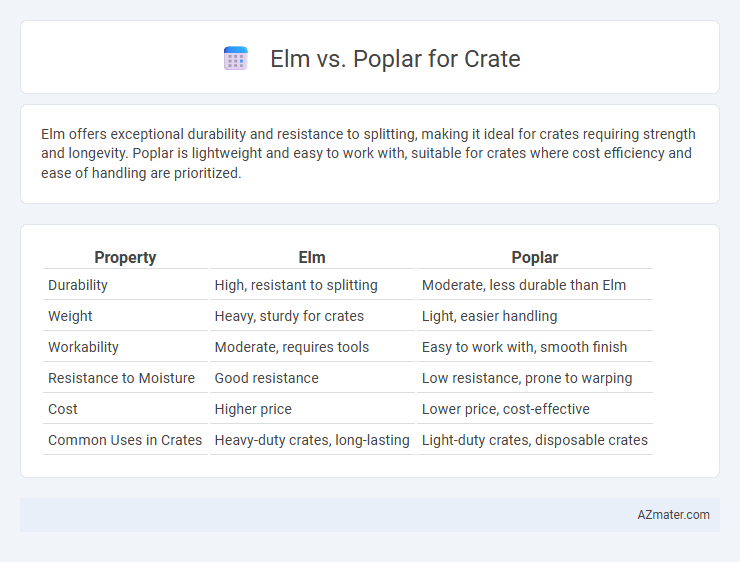Elm offers exceptional durability and resistance to splitting, making it ideal for crates requiring strength and longevity. Poplar is lightweight and easy to work with, suitable for crates where cost efficiency and ease of handling are prioritized.
Table of Comparison
| Property | Elm | Poplar |
|---|---|---|
| Durability | High, resistant to splitting | Moderate, less durable than Elm |
| Weight | Heavy, sturdy for crates | Light, easier handling |
| Workability | Moderate, requires tools | Easy to work with, smooth finish |
| Resistance to Moisture | Good resistance | Low resistance, prone to warping |
| Cost | Higher price | Lower price, cost-effective |
| Common Uses in Crates | Heavy-duty crates, long-lasting | Light-duty crates, disposable crates |
Introduction to Elm and Poplar Wood
Elm wood offers exceptional strength and durability, making it a popular choice for crate construction due to its resistance to splitting and wear. Poplar wood features a lighter weight and excellent workability, valued for its smooth finish and ease of painting or staining in crate manufacturing. Both woods provide distinct advantages, with elm favored for heavy-duty applications and poplar preferred for cost-effective, lightweight crates.
Botanical Characteristics of Elm vs Poplar
Elm trees exhibit serrated, oval leaves with prominent parallel veins and a rough texture, while Poplar leaves are typically broader, heart-shaped or triangular with smooth or slightly toothed edges. Elm bark is deeply furrowed and fissured, providing a rugged appearance, contrasting with Poplar's lighter, smoother bark that often peels in thin strips. The reproductive features also differ, as Elm produces small, winged samaras adapted for wind dispersal, whereas Poplar generates cottony seeds enclosed in capsules that aid in widespread distribution.
Workability: Machining and Handling
Elm offers superior workability for crate construction due to its excellent machining properties, allowing smooth cutting, shaping, and nailing without splitting. Poplar, while softer and lighter, machines easily but can be more prone to denting and may require careful handling during assembly. The dense grain of Elm provides enhanced durability and stability, making it preferable for crates subjected to frequent handling and rough transportation.
Strength and Durability Comparison
Elm wood is renowned for its exceptional strength and resistance to splitting, making it highly durable for heavy-duty crates exposed to rough handling. Poplar, while lighter and easier to work with, offers moderate strength and lower resistance to impact and wear compared to elm. For crate applications requiring maximum durability and longevity, elm provides superior performance due to its dense, interlocking grain structure that enhances toughness and resilience.
Weight and Hardness Differences
Elm wood typically weighs around 45-50 pounds per cubic foot and features a Janka hardness rating of approximately 830, making it moderately heavy and durable for crate construction. Poplar wood is lighter, averaging about 30-33 pounds per cubic foot with a lower Janka hardness near 540, offering easier handling but less resistance to wear. Choosing Elm provides superior strength and durability for heavy-duty crates, whereas Poplar is preferred for lightweight applications requiring moderate hardness.
Visual Appearance and Grain Patterns
Elm wood for crates is prized for its interlocking grain pattern that creates unique, swirling visuals and enhances strength, while its rich, golden-brown hue adds an attractive, rustic ambiance. Poplar displays a more uniform and straight grain with subtle, creamy white to greenish hues, offering a cleaner and lighter aesthetic ideal for a modern, minimalistic crate design. The distinct grain complexity of elm often results in a more textured and visually dynamic crate compared to the smooth and consistent appearance of poplar.
Moisture Resistance and Stability
Elm wood offers moderate moisture resistance with its dense grain structure, making it reasonably stable in humid environments but prone to warping if exposed to excessive moisture for prolonged periods. Poplar, while easy to work with and lightweight, has lower moisture resistance and tends to absorb water more readily, leading to higher risks of swelling and dimensional instability in damp conditions. For crate construction where moisture resistance and stability are critical, Elm is generally preferred due to its better durability and structural integrity under fluctuating humidity.
Cost and Availability in the Market
Elm wood is generally more expensive than poplar due to its durability and unique grain patterns, making it less common in large quantities and driving up costs. Poplar, being widely available and fast-growing, offers a cost-effective alternative with consistent supply across markets, ideal for budget-conscious crate production. Market availability for poplar remains high year-round, while elm's limited availability can lead to longer lead times and fluctuating prices.
Common Uses in Crate Manufacturing
Elm and poplar are both popular woods in crate manufacturing due to their unique properties. Elm is prized for its interlocking grain and resistance to splitting, making it ideal for crates requiring durability and strength during heavy transportation. Poplar, lighter and easier to work with, is commonly used for crates that prioritize cost-effectiveness and ease of handling while still providing sufficient protection for moderate loads.
Which Wood Should You Choose for Crates?
Elm offers superior water resistance and durability, making it ideal for crates requiring strength and long-term use. Poplar, being lighter and easier to work with, is a cost-effective choice for crates prioritizing lightweight handling and quick assembly. Choosing between elm and poplar depends on factors like crate usage, weight capacity, and environmental exposure.

Infographic: Elm vs Poplar for Crate
 azmater.com
azmater.com